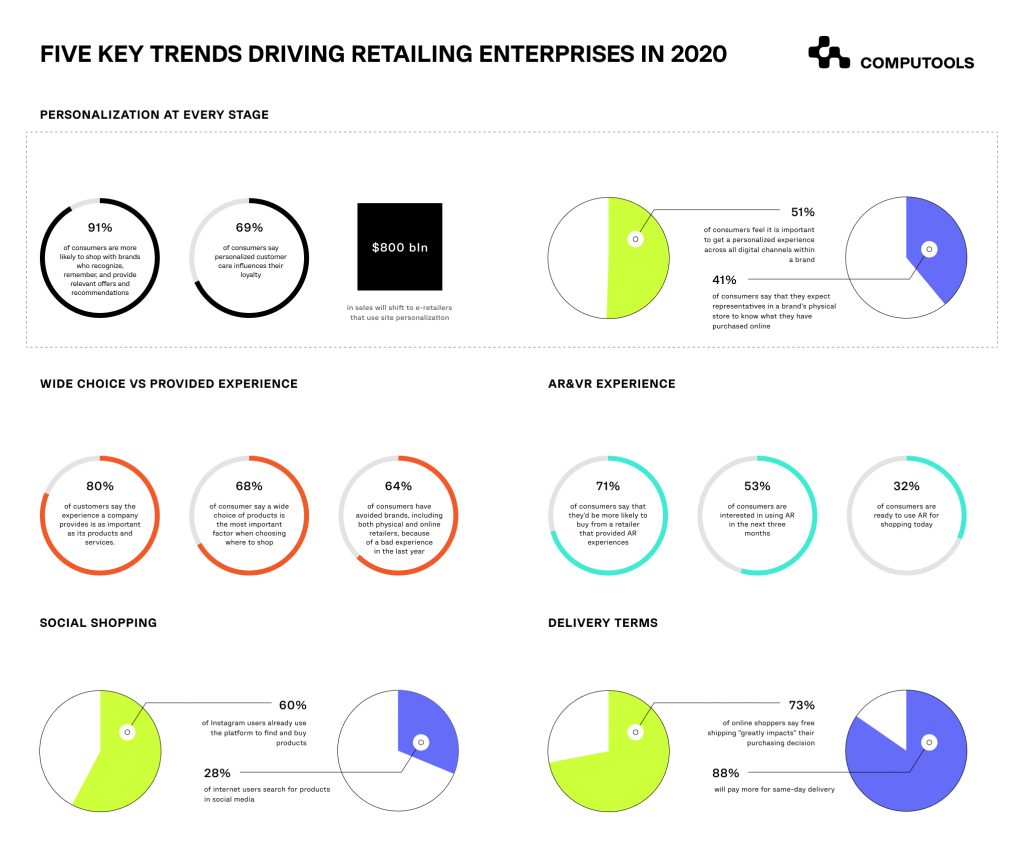Several factors influence the development and growth of the entire retail industry. However, the key one is the consumer. Most retailing enterprises have already fully adapted their business to a consumer-centric approach. However, studies show that this is no longer enough.
Consumers expect retailers to become more convenient with their purchasing experience, new solutions and proposals to simplify processes. The next trends forecast the future of retail technology and offer ways to a successful retail enterprise in the next year, since now they are more urgent than ever.
1. Augmented Reality Retail
AR is one of the most important retail trends. Augmented reality conquered the world of entertainment and continues to move to leadership positions in this field. Meanwhile, in e-commerce and retailing, it is an augmented reality that promises to be the highest expectation from consumers.
Large corporations such as Amazon and Toyota are already offering their potential customers new innovative experiences. AR technology allows experiencing all the benefits of owning a product without buying it. Thus, a customer can find out how the sofa will look in the living room before it is purchased or whether the new dress will fit the selected accessories.
By applying this retail technology, enterprises can decrease the number of returns the purchased items from online shoppers by up to 25%. Moreover, gaining new experiences attracts more consumers. The rapid development of AR technologies makes them more accessible. This means that users will strive for wider use of AR than entertainment. Meanwhile, retailing industry news state that only 23.5% of the retailing enterprises adopted this technology for their stores, and only 15% say they plan to do this in the next six months.
2. Faster Delivery Option
Consumers shop with a few simple clicks on their mobile phones. This was ensured thanks to the transformation of retail technology services. Meanwhile, shopping in a few minutes, consumers no longer agree to wait for delivery for more than one-two day. In some cases, delivery longer than a couple of hours may cause the consumer to refuse the order.
The study shows that free shipping is important for 79% of buyers, while 88% are willing to pay extra for delivery on the same day. Thus, the speed of delivery moves to the first place. Fast delivery from Amazon, food delivery services have shown that reducing delivery time is possible. The logic of the consumer is quite simple: if this company can provide such a service, why my favorite store can’t?
This is why enterprise project management and logistics require transformation and global change. Next year, only those enterprises will succeed that are able to provide their customers with delivery on time. In some cases, the issue is solved by installing new enterprise software that automates the process and speeds up the processing and assembly of orders for customers. In addition, as per research, online banking trends indicate that consumers are increasingly shifting towards digital banking solutions for their convenience, accessibility, and cost-effectiveness.

3. Smart Personalization
Personalization, personalization, personalization. This word, like a mantra, retailing enterprises repeat over the past few years. And this trend will definitely continue in the future, at least for another five to six years for sure.
Studies show that consumers appreciate those companies that value their time and are ready to save it by offering customized search and recommendations, making individual selections, and simplifying any operations in the online store. They no longer want to receive a newsletter with all the promotions and discounts, but they will be happy to receive a personalized one, where only their preferences and wishes are taken into account.
The business development strategy should include investments in the implementation of AI and ML in the processes of online retailing. These technologies, mixed with Big Data and IoT, can provide comprehensive information to the consumer, his tastes, habits, and behavior in the online store. Using this information, retailers can provide the level of personalization that consumers expect from them today.
A retailing marketing strategy should also be built on analytics and AI findings. The better a company knows its consumer, the better offers it can make for it. The whole secret of smart personalization is the timely use of smart technology.
4. Social Shopping
While startups and small businesses use social media to interact with their potential consumers, large enterprises can reap much more from this.
The new term – Instashopers – appeared due to the experimental introduction of the opportunity to purchase goods via social media. It is known that about 60% of all Instagrammers use a social network to search for and purchase the necessary goods. That is why it is necessary to include development in this direction in the retailing business plan as well.
One of the best enterprise business solutions is a visual search for social media. Let users search by uploading a photo of the dress that they saw on someone on the subway or a photo of a purse that a superstar had on the red carpet. Keywords are not always as effective as product visualization.
Visual search in one click becomes possible thanks to the use of AI. Speech recognition and voice search engines can be perfectly complemented by visuals to create maximum convenience for consumers. The combination of this technology with social media will take the enterprise to a new level.
5. More Options for Easy Return
The return of purchased goods is one of the retailing problems that can be solved by new technologies. However, while the percentage of returns is sufficiently large, consumers want the options designed for this to be as convenient as possible, because the existing ones no longer meet their requirements.
About 42% of consumers refuse to buy the item if the return policy is not transparent, not clear, or the process takes too long. About 70% of consumers refused to return an unsuitable product because the procedure required additional costs.
Consumers want more convenient and flexible choices, including more in-store returns for online purchases and designated locations to pick up and drop off packages. This is especially true for retail enterprises, who sell clothes and shoes. The consumer is more likely to buy the product if he is sure he can easily return it in case of a mistake with the size.
Another side of product returns is the refund for the purchase. As a rule, the procedure takes more than 3 banking days, and 54% of buyers expressed their desire to receive a notification on every stage of refund status.
6. Automation To Enhance Customer Service
Analyzing retail trends is critically important for businesses to stay competitive and relevant in an ever-changing market. A majority of retail customers, of up to 70%, prefer automation over human staff in at least one area of their shopping experience at local retailers. Besides, according to the report on the Future of Retail in 2023, 44% of consumers expressed a desire for automated tools that can help them check product information or inventory.
Automating specific tasks such as inventory management allows customers to have a personalized and uninterrupted shopping experience while freeing up staff time from manual tasks. With automated processes, customers can easily access inventory information and make informed decisions without having to seek assistance from staff.
Retailers can adapt to changing customer needs by investing in advanced automated software or upgrading their existing systems. eCommerce software development is an essential process for businesses looking to establish an online presence and streamline their sales processes for better customer experience and increased revenue. There are a variety of user-friendly tools to streamline inventory management, enabling retailers to track stock levels and receive timely alerts when inventory runs low, all accessible from any computer.
7. Social Media Monitoring
Social media sentiment monitoring is one of the most popular retail trends in 2023. It relates to gathering and evaluating data on the way in which people discuss a brand or retailer on social media. By using social media proactively, retailers can gain valuable insights into their customers’ opinions, preferences, and attitudes toward their business as well as their rivals.
Retailers who get many followers can leverage sentiment monitoring data to gain a more comprehensive understanding of consumer mindsets and accurately predict shifts in shopping behavior and product preferences. By monitoring social media and expanding social commerce opportunities, retailers can cultivate strong brand loyalty within their fan base.
Keeping up with current retail market trends is vital for businesses to succeed in meeting customer demands and increasing profits. Smart retailing can take the enterprise to the next level, attract more consumers and significantly increase the company’s revenues. The application of the latest technologies and investment in the implementation of innovative solutions will certainly lead to positive business results.
Discover new opportunities with advanced technology. The team at Computools has been improving retail environments for years. Contact our experts at info@computools.com to learn in detail which solutions are the most beneficial for your business.

Computools
Software Solutions
Computools is a digital consulting and software development company that delivers innovative solutions to help businesses unlock tomorrow.









“Computools was selected through an RFP process. They were shortlisted and selected from between 5 other suppliers. Computools has worked thoroughly and timely to solve all security issues and launch as agreed. Their expertise is impressive.”